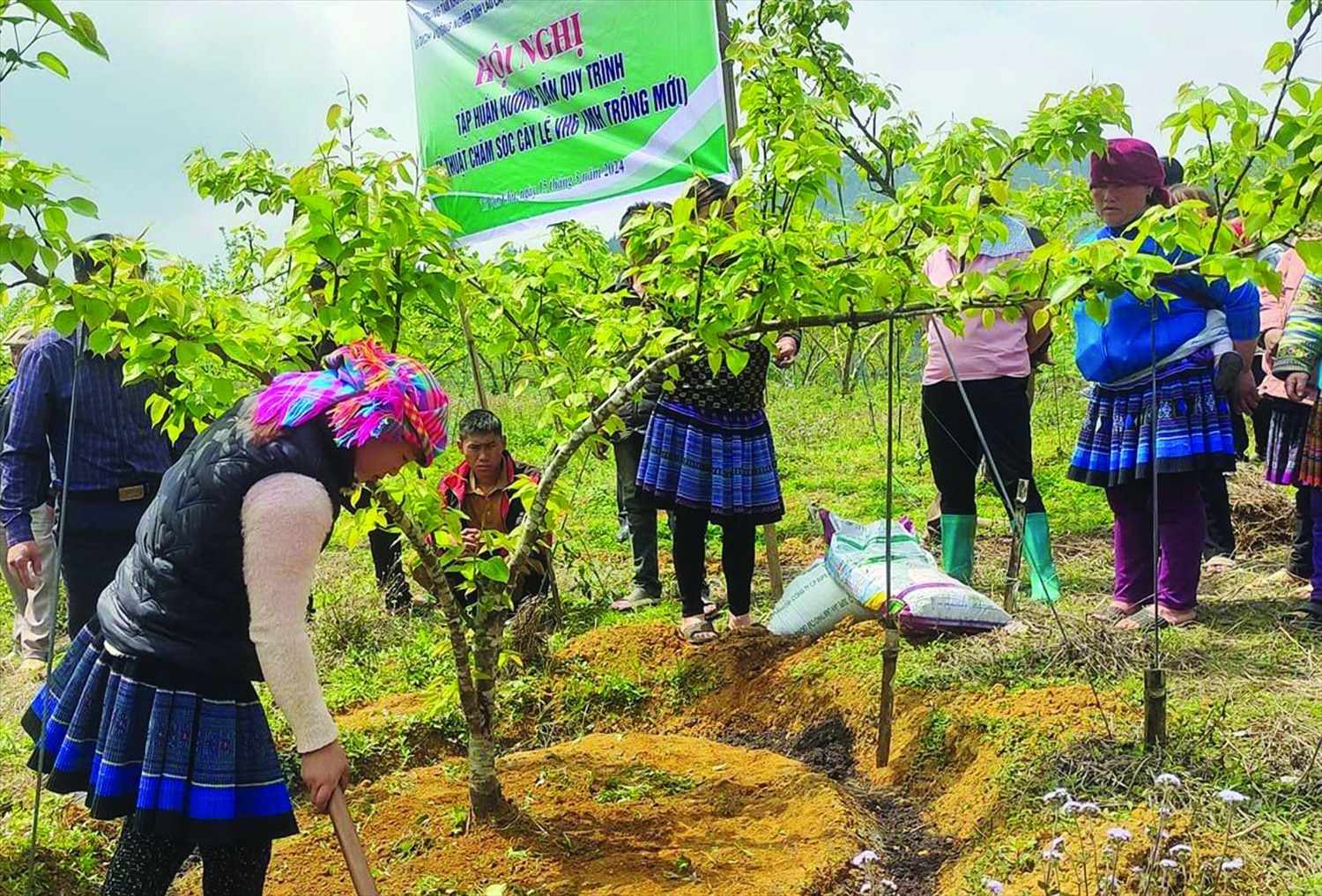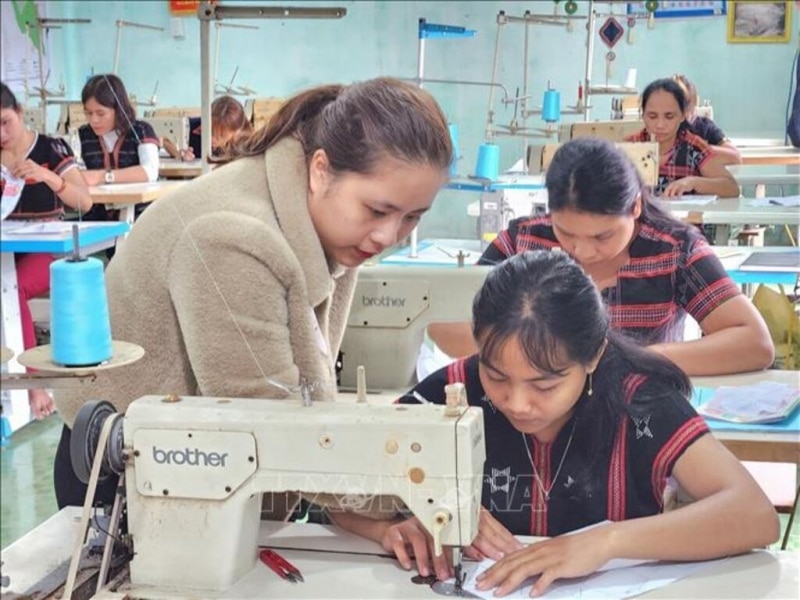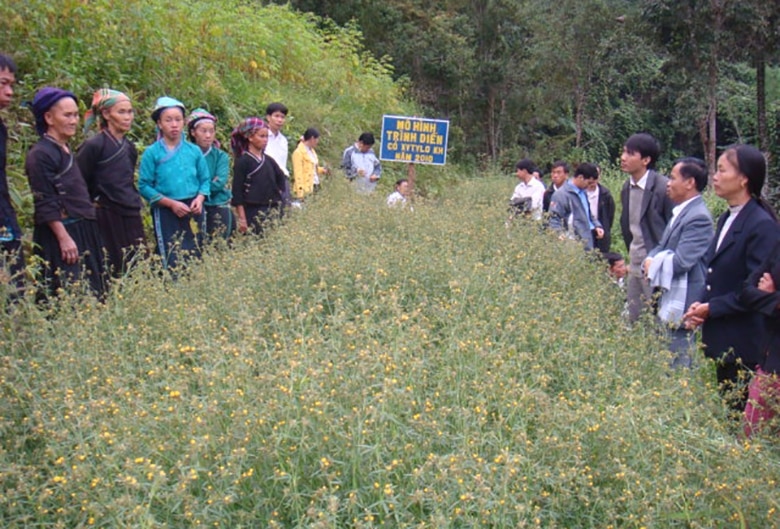
Data needed for urgent requirements
On July 10, 2024, the Central Party Secretariat issued Directive No. 37-CT/TW on innovation in vocational training for rural workers, meeting the requirements of industrialization and modernization of agriculture and rural areas.
In Directive No. 37-CT/TW, the Secretariat stated: After 10 years of implementing Directive No. 19-CT/TW dated November 5, 2012 of the 11th Party Central Committee Secretariat on strengthening the Party's leadership in vocational training for rural workers, nearly 10 million rural workers have received vocational training. Of which, nearly 4.6 million people have received vocational training support; 2.1 million people from poor households, near-poor households, people with disabilities, ethnic minorities, female workers, and policy beneficiaries have received vocational training support.
The Ministry of Labor, Invalids and Social Affairs sets a target that by 2030, 40% of ethnic minority workers will know how to work in the following sectors and occupations: industry, handicrafts, tourism , and services; 80% of ethnic minority farming households will work in commodity agriculture and forestry; and the rate of trained workers with degrees and certificates will reach 35-40% by 2030.
“However, rural workers are mainly trained at the elementary level and for less than 3 months; the training quality is still low, especially in remote areas and ethnic minority areas,” Directive No. 37-CT/TW emphasized.
While vocational training for rural workers is still limited and weak, the quality of our country's human resources is currently very low, not meeting practical requirements. According to data from the General Statistics Office, by the end of the second quarter of 2024, the country had nearly 38 million untrained workers, most of whom were rural and ethnic minority workers.
In the period of 2021 - 2025, vocational training for rural workers is supported by the state budget from 03 National Target Programs (NTPs): Sustainable poverty reduction (Sub-project 1 of Project 4); New Rural Development (Content No. 9 of Component Content No. 3); Socio-economic development of ethnic minority and mountainous areas (Sub-project 3 of Project 5).
According to the representative of the General Department of Vocational Education (Ministry of Labor, Invalids and Social Affairs), vocational training support policies under the 3 National Target Programs aim to increase the rate of trained agricultural workers to over 55%, contributing to raising the rate of trained workers with degrees and certificates nationwide to 30% by 2025.
For ethnic minority workers, vocational training support policies under the 3 National Target Programs aim to have 50% of working-age workers trained in vocational skills appropriate to their needs by 2025. According to preliminary data, there will be about 4 million ethnic minority workers trained in vocational skills. This is not a small number for a short implementation roadmap (2021 - 2025, in fact, it will only be implemented in mid-2022 due to the impact of the Covid 0-19 pandemic).
Previously, in more than 10 years of implementing Project 1956 on vocational training for rural workers until 2020 (according to Decision No. 1956/QD-TTg dated November 27, 2009, amended by Decision 971/QD-TTg dated July 1, 2015), the whole country had only trained more than 1.1 million ethnic minority workers. During this period, the majority of ethnic minority workers were trained in agricultural occupations, with training duration of less than 3 months.
Therefore, by 2019, the results of the socio-economic survey of 53 ethnic minorities showed that, of the 8.03 million ethnic minorities aged 15 and over participating in the labor force, only 10.3% of the labor force had received training, mainly at the elementary level. Among the untrained ethnic minority laborers collected in the 2019 survey, there were many who had received vocational training for less than 3 months, but forgot their profession after being trained for many reasons.

Thus, to achieve the policy goals in the 3 National Target Programs, innovation in vocational training for rural workers, especially those in remote, ethnic minority and mountainous areas, has been and is an urgent requirement. However, to comprehensively innovate according to the requirements of the Secretariat in Directive No. 37-CT/TW dated July 10, 2024, there must be accurate data on the current labor - employment situation of ethnic minority workers; it is necessary to separate rural workers in general and ethnic minority workers in particular, in each locality and each ethnic group.
This request is being carried out in the investigation, collecting information on the socio-economic situation of 53 ethnic minorities in 2024. With the set of questions on the field of labor - employment in the ethnic minority household survey, compared with the data in the commune survey, it is expected to produce accurate parameters for ministries, branches and localities to innovate vocational training for rural workers in general and ethnic minority workers in particular.
Solving sustainable employment
More than 10 years ago, when supervising the implementation of Project 1956 to support vocational training for ethnic minority workers, the National Assembly's Ethnic Council determined that ethnic minority workers mainly work in agriculture, forestry and fishery (accounting for 70%); only about 2.86% of workers have received vocational training, the vast majority of which are less than 3 months.
Meanwhile, the transfer and application of science, technology and engineering to labor, production and industrial development in mountainous areas and ethnic minority areas are still very limited (in Report No. 581/BC-HDDT13, dated October 25, 2013).
Emphasizing the significance of vocational training for ethnic minority workers, the National Assembly's Ethnic Council recommended that in the process of implementing Project 1956 in ethnic minority and mountainous areas, the Government should have written instructions, create conditions and policies to encourage businesses, economic sectors, and non-public vocational training institutions to participate in vocational training and education associated with attracting workers to businesses.

Improving knowledge and production skills for farmers and ethnic minority workers means improving their self-mobilization capacity to overcome hunger and reduce poverty, and develop the economy for farmers and ethnic minorities sustainably.
Excerpt from Report No. 581/BC-HDDT13 of the National Assembly's Council of Nationalities.
This is a solution that contributes to promoting economic restructuring in rural and mountainous areas, creating jobs, creating livelihoods, and increasing income for ethnic minority workers.
At the same time, this is also a solution to "reduce" the pressure when implementing policies to support production land in ethnic minority and mountainous areas, in the context that many localities no longer have land funds.
But as mentioned above, approaching Project 1956, ethnic minority workers mainly study agricultural occupations (the proportion of studying industrial and service occupations accounts for only 27%). Vocational training is undertaken by public institutions, with businesses almost absent.
According to the assessment of the Ministry of Labor, Invalids and Social Affairs in the report summarizing 10 years of implementing Project 1956, not only do they not participate, but some business owners also refuse to accept students from vocational training classes to practice and intern at their businesses for fear of affecting productivity and product quality. Therefore, ethnic minority workers still work in agriculture, whether or not they have received vocational training.
In 2019, the results of the investigation and collection of information on the socio-economic situation of 53 ethnic minorities showed that 7.9/8.03 million ethnic minority workers had jobs, but 73.3% of them worked in the agriculture - forestry - fishery sector (the national rate is 35.3%); only 14.8% of workers had jobs in the industry and construction sector; 11.9% worked in services.
Therefore, the average income of ethnic minority workers is very low, about 1.1 million VND/person/month; the lowest is the Mang ethnic group (436.3 thousand VND/person/month). While the average income of the whole country in 2019 reached 4.2 million VND/person/month.
Based on the data on labor and employment in the socio-economic situation survey of 53 ethnic minorities in 2019, in order to "position" sustainable employment for ethnic minority labor, from 2021, the mechanism for implementing vocational training support policies in the 3 National Target Programs has been built more closely, linking training with solving employment problems.

Specifically, in Circular 15/2022/TT-BTC guiding the implementation of the National Target Programs for the period 2021 - 2025, the Ministry of Finance stipulates that support for the implementation of vocational training models and the organization of vocational training classes for ethnic minority and mountainous laborers is carried out in the form of ordering, assigning tasks or bidding. This mechanism is to encourage businesses to participate in vocational training associated with solving labor problems for ethnic minority laborers.
Thanks to that, in many localities in ethnic minority and mountainous areas, the number of skilled workers outside the agriculture - forestry - fishery sector has increased, contributing to promoting economic restructuring. For example, in Soc Trang, in the period of 2021 - 2023, the whole province has solved the labor problem for 43,880 workers, including over 7,800 ethnic minority workers.
Also during this period, the province recruited 29,705 people for vocational training; of which, 4,670 were ethnic minorities. The rate of having jobs after training reached over 90%; of which, the rate of ethnic minority students having jobs after vocational training reached over 97.93%.
With a strict mechanism in implementing support policies under the 3 National Target Programs for the period 2021 - 2025, the shortcomings and limitations in vocational training for rural workers and ethnic minority workers are expected to be overcome; localities will achieve positive results like in Soc Trang province.
In the future, when the results of the investigation and information collection on the socio-economic situation of 53 ethnic minorities are handed over, the Ethnic Committee will coordinate with relevant ministries, agencies, units and organizations to analyze the labor situation to have policy orientations in the next period.
According to the General Statistics Office, by the end of the second quarter of 2024, the country had 52.5 million workers aged 15 and over, but the rate of trained workers with degrees and certificates was only 28%. Previously, in 2023, the rate of trained workers nationwide was 27.6% of the total 52.4 million workers aged 15 and over, an increase of 0.3% compared to 2022 (27.3%). Thus, vocational training is still 2% away from the target, to achieve the target of 30% trained workers by 2025. Not to mention, according to the forecast of the Ministry of Planning and Investment, by 2025, the labor force aged 15 and over in our country will increase to 58.7 million people, which will continue to increase the rate of trained workers with degrees and certificates.
Policy planning from the results of the survey on the economic situation of ethnic minority households: Improving basic living conditions (Part 7)


![[Photo] Readers line up to visit the photo exhibition and receive a special publication commemorating the 135th birthday of President Ho Chi Minh at Nhan Dan Newspaper](https://vphoto.vietnam.vn/thumb/1200x675/vietnam/resource/IMAGE/2025/5/17/85b3197fc6bd43e6a9ee4db15101005b)



![[Photo] More than 17,000 candidates participate in the 2025 SPT Competency Assessment Test of Hanoi National University of Education](https://vphoto.vietnam.vn/thumb/1200x675/vietnam/resource/IMAGE/2025/5/17/e538d9a1636c407cbb211b314e6303fd)
![[Photo] Prime Minister Pham Minh Chinh chairs meeting on science and technology development](https://vphoto.vietnam.vn/thumb/1200x675/vietnam/resource/IMAGE/2025/5/17/ae80dd74c384439789b12013c738a045)



























![[Photo] Nearly 3,000 students moved by stories about soldiers](https://vphoto.vietnam.vn/thumb/1200x675/vietnam/resource/IMAGE/2025/5/17/21da57c8241e42438b423eaa37215e0e)

































































Comment (0)